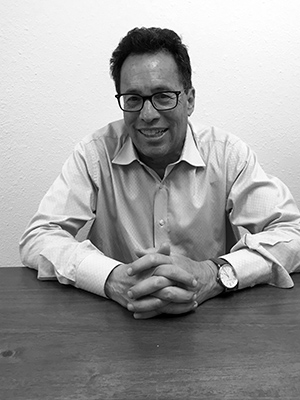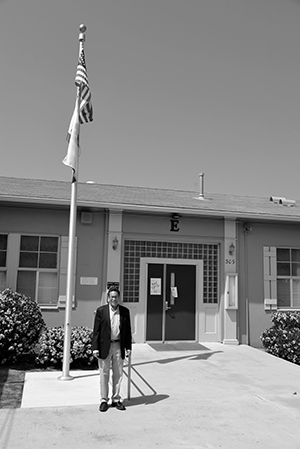 Editor’s Note: This is the 3rd chapter in Volume 3 of Editor Emeritus Donald H. Harrison’s 2022 trilogy, “Schlepping and Schmoozing Along the Interstate 5.” All three books as well as others written by Harrison may be purchased from Amazon.com.
Editor’s Note: This is the 3rd chapter in Volume 3 of Editor Emeritus Donald H. Harrison’s 2022 trilogy, “Schlepping and Schmoozing Along the Interstate 5.” All three books as well as others written by Harrison may be purchased from Amazon.com.
Schlepping and Schmoozing Along the Interstate 5, Volume 3, Exit 37 (Lomas Santa Fe Drive): Solana Beach Elementary School District
From northbound Interstate 5, take the Lomas Santa Fe exit and turn left. Go 3/10th of a mile to a right turn on North Rios Avenue. The School District offices are on the left at 309 North Rios Avenue.
 SOLANA BEACH, California – Rich Leib knows a thing or two about chairing meetings. He was appointed by Gov. Gray Davis in 1998 to the California Community Colleges Board of Governors, serving as its president from 2001 to 2003. In 2008, he was elected to the Solana Beach School Board, where he served for nearly 12 years, part of that time as that body’s president. In 2018, Gov. Jerry Brown named him to the UC Board of Regents. When the chair of that board, Cecilia V. Estolano, was not reappointed, Leib moved up from vice chair to chair. In July 2022, he was formally appointed to a one-year term as the Regents’ chairman.
SOLANA BEACH, California – Rich Leib knows a thing or two about chairing meetings. He was appointed by Gov. Gray Davis in 1998 to the California Community Colleges Board of Governors, serving as its president from 2001 to 2003. In 2008, he was elected to the Solana Beach School Board, where he served for nearly 12 years, part of that time as that body’s president. In 2018, Gov. Jerry Brown named him to the UC Board of Regents. When the chair of that board, Cecilia V. Estolano, was not reappointed, Leib moved up from vice chair to chair. In July 2022, he was formally appointed to a one-year term as the Regents’ chairman.

During a March 2022 interview with Leib, I wonder how he goes about exercising leadership on decision-making boards.
“When you are president of a board, what you really need to do is respect and understand all of your colleagues,” he responded. “Make sure that they are getting the attention and that the things that they are interested in are getting worked on. My biggest strength lies in working well with people, understanding what they need, and what their priorities are. On every single board that I have ever worked on, there are other board members who are much smarter than I am, who are much more knowledgeable. The key is to utilize that. Always surround yourself with better people than yourself in terms of intellectual pursuits.”
The idea, he said, is to help the other board members be stars. “You have to work with your members,” he added. “If you are just a show-boater and you are the president or chair of a board, it is not going to go well.”

The Solana Beach Elementary School District has seven schools serving 3,000 students compared to the University of California, which has ten campuses serving 282,000 students. UC also operates five hospitals with a lot of money coming in for research. So, the University of California is not only 94 times bigger than the Solana Beach district in terms of students; it is also far more complex. Its revenues are $40 billion per year, with $20 billion from the campuses and $20 billion from the hospitals, Leib told me.
The California Community Colleges Board is less involved in administrative issues than the two other boards, because most policy decisions at districts like the San Diego Community Colleges are made at the local level. “The most important thing you can do at the California Community Colleges Board is to get more money from the state” to support programs for more than 2 million students at the 116 community colleges throughout California, he said.
Looking back at his time on the Solana Beach Elementary School Board, Leib said he decided to run for the seat in order to block “single-issue candidates” from turning the board into an ideological forum. “I came into the district when it was doing a good job, and I didn’t want to screw it up,” he said. “I succeeded in that I didn’t screw things up!”
Leib’s interest in education may be traced back to his mother, Joan, a divorcee who taught English at Venice High School in Los Angeles. “She was a great influence on me,” Leib said. “One of the things that was most important to her was that I get into a UC.” At the time, he was less than a stellar student at Hamilton High School on Los Angeles’ west side. He was more interested in electoral politics than he was in schoolwork. In 1974, he accompanied Congressman Jerome Waldie on a walk through California as an attention-getting device in his unsuccessful primary election campaign for governor, a contest that was won by Jerry Brown.
Leib struggled to maintain a 3.3 average, which was then required for admission to a University of California. (The standards are much higher today). “If my average had been only 3.15, I wouldn’t have gotten in because my SAT (Scholastic Aptitude Test) wasn’t that high. She was very proud that I got into the UC.”
He was accepted at UC Santa Barbara, where in the 1978-79 academic year, he served as the student body president. He also served as the overnight disc jockey on KCSB, the student-run radio station offering alternative music. Leib chose to host a country western radio program in which he billed himself as “The Kosher Kowboy.” Today, he is still a country music fan, a passion he shares with San Diegan Toni Atkins, the president pro tempore of the state Senate, who was one of the principal advocates for his appointment to the UC Board of Regents.
Following graduation from UC Santa Barbara, Leib was awarded a CORO fellowship, which is a program that takes fellows behind the scenes of government, business, labor, media, philanthropy, and electoral politics to teach leadership skills and help them build networks. The fellowship led to Leib’s master’s degree in public affairs from the Claremont Graduate School.
Thereafter, Leib engaged his passion for politics. He ran unsuccessfully for Santa Barbara City Council in a race in which he was accused of being a carpet bagger because he moved into the City of Santa Barbara from nearby Goleta, which neighbors the UC Santa Barbara campus. Worse, columnist Walker A. Tompkins of the Santa Barbara News-Press, reporting a friend’s allegation that Leib’s mailer had twisted facts, said that was a “kike” thing to do – an antisemitic slur for which the columnist later apologized.
Leib became increasingly savvy about the ways of government, serving variously on the staffs of State Senators Gary Hart and Herschel Rosenthal, and for Gray Davis when he was the state controller. A Democratic activist, he also worked in the campaigns of Congressmen Henry Waxman and Mel Levine, both of Los Angeles.
Leib’s reference to his SAT score led to a discussion about a decision made in November 2020 by the UC Board of Regents to no longer use SAT and ACT (American College Test) scores in determining which students should be admitted to the University of California.
“A lot of people were upset about that,” Leib acknowledged. “The ACT and the SAT years ago were really driven in the 1950s by Jewish families and others who felt they were deprived of getting into some of these elite Eastern schools – Harvard, Yale, and the other Ivy League schools – which were heavily based on family connections, legacies, and development givers. The SAT was devised to help those kids who were really smart to demonstrate an objective criterion that you could use to get in.”
However, “a lot of kids who have money are able to do a lot of testing and practicing and have coaching to help them with their SAT,” Leib said. “If the SAT is such an important thing, then why aren’t we teaching it in our school districts? Why do you have to go beyond and above to get trained for this? There is no question in my mind that if you go to one of these prep classes and get coached, the more money you pay, the better you will do, which defeats the purpose of what the SAT is supposed to be about. When I went to college, they said you can’t study for the SAT. Well, the evidence is overwhelming that you can. My own kids (Hannah, Joelle and Lilyanne, now adults) did better on their SAT scores the second time around when they had coaching. I saw that myself. A good SAT score generally correlates to first-year grades. However, the correlation fades. By the fourth year, there is no correlation at all. To me, it doesn’t matter so much what happens in the first year; it is what happens in the last year.”
So, he said, rather than equalizing high school students’ chances to get into college, “it is kind of a way of keeping people out of the system. It did not make sense for me to continue the SAT. I think it is more of a barrier.”
Leib said there is a misconception that the SAT is a measurement that permits the University of California to tell the difference between “A” students from different high schools, which may have variable grading standards. “That is not the way it works in the UC system,” he said. “Every high school is judged on its own merits. So, students going to school in National City are judged against students from the same school. What parents don’t realize is that if they put their kids in the best school possible, that ends up being harder than you think. Unless your kids are the outstanding kids, they may not get into a UC. They would have done better if they had gone to a less competitive school at which they could have excelled in comparison to the other kids.”
Other criteria evaluated by UC admission offices include “how rigorous was your ninth-grade program? How rigorous was your twelfth-grade program? They look at your grades and how they went. Did they start high and stay high? Did they start high and go low? Did they go low and start getting better as time went by? All these are factors that are counted in. How many AP (Advanced Placement) courses did you take? What are your extracurricular activities? What do your essays look like? There are 13 criteria that they use.”
One of the first committees that Leib served on following his appointment to the Board of Regents was that which deals with technology transfers – the licensing for commercial use of discoveries made by University of California researchers.
“We have an incredible number of inventions, but we have a very bad bureaucracy that really prohibits quickness and being nimble,” he said. He advocates allowing the individual campus administrations to make licensing decisions without having to go to the Office of the President of the University of California. “These schools are so big and doing so well, they can handle a lot of this technology,” he said. Some 40 employees in the Office of the President do not add value to the process, he said. He recommended that they be assigned to the individual campuses, or failing that, be shifted into other kinds of programs. “What I am looking at is doing a mentoring program between kids and professionals in the field. We’re talking about honoring people for their inventions, so there is some recognition; establishing metrics so we can show the world what we are doing.”
Another priority for Leib is rebuilding good relationships with the Legislature and the Governor’s office, which he said deteriorated during the administration of UC President Janet Napolitano. “As she had been a governor of Arizona and later the Secretary of Homeland Security under President Barack Obama, the Regents were hoping that she would be really good at establishing a strong relations with Governor Brown and the legislative leadership, but unfortunately for a variety of reasons, that did not happen,” Leib said. “Part of the problem was that we were dealing with budget cuts and other fiscal problems and part of the problem was a style and personality conflict with the leaders of California.”
“She is a very decent and well-intentioned person but didn’t have the ability to work closely with the Governor and Legislature and that was a real problem,” said Leib.
The current UC President, Michael Drake, “is much better at communicating well with legislators, Leib said. “I have been very active in trying to get a better relationship with Sacramento, which I think we have achieved. Part of that is that we have bought a building next to the Capitol. It will be our center point not only for our internship program, where we bring students up to Sacramento all the time. We are going to be having our lecturers who are doing so much work on climate change and other important issues to come and speak to people including legislators. It will become a public policy institution in Sacramento where will have our speakers give the economic analyses and all the things the legislators can use, so that we can, again, develop a better working relationship with the Legislature.”
Funding by the Legislature and Governor can have a vital impact on the number of California students who are admitted to the ten UC campuses. At one point prior when relationships were tense, legislators voted less money to the University of California, prompting the campuses to admit more out-of-state and foreign students who each account for approximately $30,000 a year in revenue to the university. Out-of-state admissions climbed at UC Berkeley and UCLA to 25 percent of the new admissions, providing approximately $1 billion per year to those campuses. “They relied on that as the Legislature gave less money,” Leib commented. “I felt like the pendulum has swung too far. There is too much emphasis on trying to recruit out-of-state and foreign students at the expense of Californians who pay taxes.”
The Regents decided that other campuses should not follow in the footsteps of UCLA and UC Berkeley at 25 percent out-of-state admissions. They capped other campuses, such as San Diego, Santa Barbara, Santa Cruz, Riverside, and Merced at 18 percent. That was a compromise. Some wanted it to be 20 percent; Leib favored 15 percent. The Legislature lately has been giving more money, opening up more spots. They are supplanting the revenue of $30,000 per student by buying spots for local students.”
Among reasons that Leib was concerned about the impact of admitting out-of-state students was because it complicated his goal to radically diversify the student body at the University of California. “When I went to UCSB 40 years ago, only 2 percent of the student population was Black and if you go back today, it is the same thing, 2 percent,” Leib said. “We have made great strides with the Asian community and the Latino community, but we have not made that kind of strides with the Black community. One of the ways we can do it is building programs where money is spent on getting people prepared for college. That involves identifying people early in their life and trying to help them with whatever preparation they need so they become UC-eligible. It is not an easy thing to do because you spend a lot of money and a lot of these kids end up getting accepted at wildly prestigious East Coast schools, so you lose them obviously. You need to really work at increasing the pool. I think we have a 6 percent Black population in California and 2 percent at UC’s, so we need to do a better job.”
Yet another priority for Leib is increasing at all 10 UC campuses the amount of funds available for mental health treatment. “The good news is that mental health no longer is a stigma that people are unwilling to talk about. If you go on campus, people will readily admit when they have mental health issues and that they need help. There is a lot of money that the state offers for mental health and we’re not accessing it very well. The counties have a lot of money for programs under Prop. 63, the mental health initiative that was passed in 2005. It taxes the wealthiest Californians, those who make over $1 million annually – a one percent surcharge tax. This year that raised almost $4 billion for mental health. Much of that could go to campuses, but it does not, so I am working really hard to access that money and leverage it to get better mental health.”
I asked Leib about the local campaign to win approval for a University of California campus in Chula Vista or elsewhere in the South Bay.
“I think it would be very difficult for a lot of reasons,” he answered. “We spent billions for Merced. It is a very expensive process. At the time I was wondering if it was worth it. I am now convinced 100 percent that it is, that it is servicing an area that was not being serviced in other ways and people did not have a UC near them. Now, we have this great university that is coming along. As a matter of fact, the second highest percentage of kids who get PhD’s come from Merced. Only Berkeley, not by numbers but percentage wise, produces more undergraduates who end up getting PhDs. You are getting great benefits by having a UC campus there. The problem for Chula Vita is that it is very expensive. We don’t have the resources to go out and buy all the land and what it would take to get a UC in Chula Vista. And frankly, it is pretty close to San Diego, close enough that I really don’t see it being on the horizon, unfortunately.”
*
In 1990, a year after graduating from Loyola Law School, Leib married fellow attorney Sharon Rosen, who later became an award-winning freelance Jewish journalist. Her 2021 article in the Forward on the Academy Museum’s failure to acknowledge the Jewish pioneers of the movie industry received global media attention and prompted the museum to acknowledge its error and develop a permanent exhibit on the movie moguls of yesteryear. Her passion for this subject stems from the fact that her great-grandfather Sol M. Wurtzel ran Fox Studio in Hollywood for his boss William Fox. In 2020, other stories she wrote for the Forward garnered a Simon Rockower Award from the American Jewish Press Association.
The couple’s three daughters are Hannah, a clinical social worker; Joelle, a law clerk for a federal magistrate in Orange County; and Lilyanne, who works for the online MasterClass, which features celebrities in teaching roles.
Leib broadened his political education from 1991 to 1992 when he worked as an assistant in San Francisco to Democratic party financier and real estate developer Walter Shorenstein.
Serving on education boards was strictly a voluntary pursuit for Leib; none of the positions came with a salary. He was able to spend so much time in this pursuit because he and Alan Viterbi collaborated on two financially successful businesses. The first, which prompted Leib to move to San Diego County, was U.S. Public Technologies, which marketed cameras at traffic signals by municipalities. From 1994 until that business was sold in 2000 to Lockheed Martin, Leib handled the company’s legislative and regulatory issue in 13 western states.
After staying on for two years with Lockheed Martin to transition the business, Viterbi and Leib partnered in 2002 and were later joined by Dana King and Pat Reilly in Liquid Environmental Solutions. That company grew from 90 to 700 employees assisting large business chains such as Walmart and Target, as well as restaurant chains, in safely collecting, transporting, processing, recycling, reclaiming, and disposing such non-hazardous wastes as grease from their traps. That business was purchased by a private equity firm in 2017, a year before Leib’s appointment to the Board of Regents. Dana King also joined the Solana Beach Elementary School District board.
A former board member of Temple Solel, Leib said that he “participated in the capital campaign and in the selection of Rabbi [Alexis] Berk” but since then has “not been all that involved.” He remained on the board of the North Coast Repertory Theatre, to which he recruited Marc Tayer, who now serves as its chairman. As with Temple Solel, he said, he has cut back his involvement because of the time he must spend on University of California business.
Leib continues to announce the games of the San Diego County Miracle League, in which baseball players with special needs participate on Saturdays at San Dieguito County Park. Utilizing the radio voice that he developed as a student as UC Santa Barbara, Leib announces the game at which everyone has a “fantastic time. We have a special field at San Dieguito County Park for wheelchairs. Everybody gets a hit; nobody gets out. The games are always tied. It is an incredibly exciting game. They tie it up with the last batter, who gets the last hit, and everybody loves it. It is a fun time. A lot of former Padres like Brad Ausmus come out and do the pitching. It gives me an opportunity to razz them. Mark Kotsay, the manager of the Oakland A’s, lives in Rancho Santa Fe, so it is easy for him to come down in the off-season. The kids love it; it is so much fun, and it is the happiest moment of the week.”
*
Donald H. Harrison is editor emeritus of San Diego Jewish World. He may be contacted via donald.harrison@sdjewishworld.com